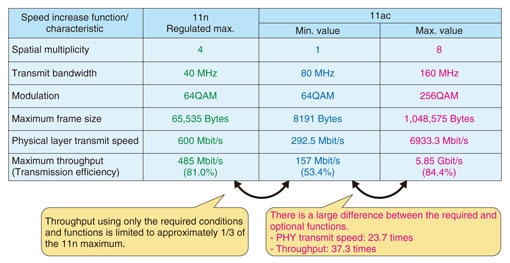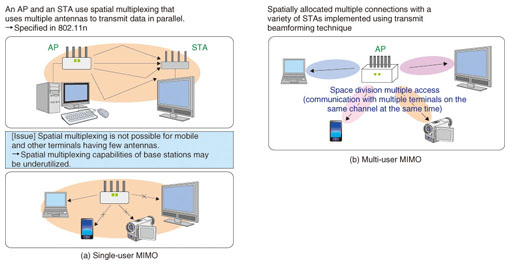 |
|||||||
|
|
|||||||
|
Global Standardization Activities Vol. 11, No. 10, pp. 33–39, Oct. 2013. https://doi.org/10.53829/ntr201310gls IEEE 802.11 Wireless LAN Standardization TrendsAbstractThis article gives an overview of the Institute of Electrical and Electronics Engineers (IEEE) 802.11 Working Group (WG), which creates standards for wireless local area networks (LANs). We include information on its relationships with external organizations, its standardization processes, and a list of existing amendments to IEEE 802.11. Some of the latest trends in standardization are also introduced, including IEEE 802.11ac, which is an amendment of the IEEE 802.11 standard to increase system throughput, and we explain the status of the High Efficiency WLAN Study Group (HEW SG), which has begun standardization work to enhance transmission efficiency in high-density deployment of access points and stations. Keywords: IEEE 802.11, wireless LAN, multi-user MIMO 1. Overview of 802.11 WGThe Institute of Electrical and Electronics Engineers (IEEE) 802 Committee (from here on, "802 Commitee") is the organization that develops and maintains standards for the physical and data-link layers of transmission media for wired and wireless networks. The 802.11 Working Group (WG) was established within this organization in 1990 to create standards for implementing wireless Ethernet. The 802.11 WG carries out development by cooperating widely with standardization and industry organizations within and outside of the 802 subcommittees (Fig. 1). In particular, the Wi-Fi Alliance, which certifies interoperability among IEEE 802.11 wireless local area network (LAN) devices, has played a large role in the explosive spread of wireless LAN products [1]. As shown in Fig. 2, since the initial 802.11 standard was published, it has been extended with many amendments that address the increasing speed and functionality, which include faster transmission speeds (802.11a/b/g/n/ac/ad), priority control based on type of traffic (802.11e/aa/ae), security improvements (802.11i/w), extended wireless LAN functionality (802.11F/h/k/r/s/u/v/z), and support for frequencies used in different countries (802.11d/j/y).
2. 802.11 WG standardization processThe standardization process adhered to in the 802.11 WG is as follows. First, the needs for a new standard for future wireless LAN systems are discussed in the Wireless LAN Next-Generation Standing Committee (WNG SC). Here, the need for a new standard is proposed, and if this is approved by the New Standard Committee (NesCom) in the IEEE Standards Association (IEEE-SA), which is a higher-level organization of the 802.11 WG, a study group (SG) is established. In the SG, a prospectus is created that outlines the goals of the new standard to be created, including the scope, marketability and feasibility of the study. After the prospectus is approved, a task group (TG) is established, and concrete discussion toward creating the specification begins. The TG decides, to some extent at its own discretion, how the work will proceed. The following is one example. First, documents summarizing the functional requirements to achieve the goals of the activity and the evaluation methodology for each technical proposal are created. Then, technical proposals that satisfy these conditions are invited. If there are multiple competing proposals, the technology to be used is narrowed-down through voting or other means. After a single technical specification has been selected, a draft summarizing the basic technical specifications is created. The 802.11 WG and the IEEE-SA hold an electronic ballot to vote on the draft. In each ballot, voting members vote to either support the specification of the draft or not, and they optionally attach comments for revision. The TG resolves these comments by revising the draft as necessary; then the next electronic ballot is carried out. This process is repeated until the comments are resolved through the ballot and voting process and the approval rate meets certain prescribed conditions. Finally, when the proposal receives approval by the 802 Committee, it is published as a standard specification. 3. Status of work in 802.11 WGThe active TGs and SG in the 802.11 WG, as of July 2013, are listed in Table 1. This article focuses on the activities of the following two groups in creating amendments of the 802.11 standard for increasing throughput. The current state of their work is also discussed.
1. TGac, which is working on creation of the standard that achieves system throughput of 1 Gbit/s and greater. 2. The High Efficiency WLAN SG (HEW SG), which is preparing to form a TG to work on realizing high system capacity in the dense deployment of wireless LAN access points (APs) and stations (STAs). 3.1 Status of TGacTGac began its activities in November 2008; these activities concerned the next generation of wireless LAN to follow 802.11n, which has been widely adopted. It assumes use of the 5-GHz band. TGac has set the following two target values for speed increases: (1) Throughput of 500 Mbit/s on a single wireless link (2) Total throughput of 1 Gbit/s on multiple wireless links For target (2), a multi-user MIMO (multiple input, multiple output) (MU-MIMO) technology that extends the MIMO technology specified in 802.11n, is adopted to achieve simultaneous transmission to multiple STAs over the same frequency band. Experimental results from NTT's testbed in real environments [2] are being used to confirm the feasibility of this technology. The technologies to be adopted have been refined over approximately two years since TGac began its activities, and the work of conducting ballots and revising the draft is still continuing. As of September 2013, the work to resolve comments on the sixth edition draft (D6.0) had been finished, and efforts are proceeding on target to complete standardization by February 2014. 3.2 802.11ac Specification for throughput enhancementFor target (1) (increasing the speed of individual wireless links), the techniques already defined in 802.11n such as spatial multiplexing, and techniques related to channel bandwidth and the number of constellation points have been extended further (Fig. 3). Wideband transmission using the 80-MHz or 160-MHz channel specified in 11ac was not previously allowed under Japanese Radio Regulatory Rules, but recent changes in the regulatory rules in March 2013 make it possible to use these bandwidths. There are also large differences between the mandatory conditions, which must be supported, and the maximum provisions in 802.11ac (Table 2). This is intended to reflect the diversifying needs of wireless LAN terminals and to impart high scalability.
To achieve target (2) (increasing system throughput by transmitting over multiple wireless links simultaneously), MU-MIMO technology is specified for the downlink (DL) transmissions. An AP transmits to up to four STAs simultaneously using beamforming techniques to cancel inter-user interference in order to implement simultaneous transmission to multiple STAs. Single-user MIMO (SU-MIMO) technology, which transmits between individual STAs using spatial multiplexing, is already specified in 802.11n. Additionally, 802.11ac defines DL MU-MIMO technology, which enables increases in transmission efficiency without requiring multiple receiver antennas or complex signal processing at each destination (Fig. 4). The 802.11ac standard specifies wireless frame formats, methods for allocating user groups, methods for channel state information feedback observed at each STA in order to achieve transmit beamforming, and other aspects needed to implement DL MU-MIMO transmission. With DL MU-MIMO technology, even if STAs do not support SU-MIMO technology, the AP's spatial multiplexing transmission using transmit beamforming makes it possible to transmit multiple frames to different STAs simultaneously over the same frequency band, which enhances the total system throughput.
In addition to a variety of transmission modes including combinations of spatial multiplexing, transmission bandwidth, and SU/MU-MIMO transmission, 802.11ac defines the frame format encapsulated in the same header format as 802.11a/n. This format enables compatibility among 802.11a/n/ac transmissions on the 5-GHz band. 3.3 Status of HEW SGRecently, wireless LAN has been widely deployed. These networks are now being implemented in mobile terminals such as notebook PCs, smartphones, and tablet computers. Transmission speeds have also increased to up to several hundred Mbit/s with the advent of 802.11ac. However, the frequencies available for wireless LAN are severely limited. These frequencies are also used by many wireless LAN systems in crowded environments such as train stations and airports, which results in problems such as significantly reduced transmission speeds and longer times required to connect to the network. The WNG SC has been deliberating on these conditions in its discussions of next-generation wireless LAN systems to follow 802.11ac since the end of 2011, including the need to increase transmission efficiency in environments with a high concentration of terminals. At the March 2013 meeting, a motion to establish a new SG was approved, which had been proposed jointly by 19 companies including NTT. The motion to establish the HEW SG confirmed the need to begin working on various issues. The proposal was as follows. "Do you support starting a new study group called high efficiency WLAN to enhance 802.11 PHY and MAC in 2.4 and 5 GHz with a focus on: - Improving spectrum efficiency and area throughput - Improving real world performance in indoor and outdoor deployments - in the presence of interfering sources, dense heterogeneous networks - in moderate to heavy user loaded APs?" The HEW SG began its activities at the May 2013 meeting [3]. At that meeting, the following officers of the SG were elected: - Chair: Osama Aboul-Magd (Huawei Technologies) - Secretary: Yasuhiko Inoue (NTT) 4. SummaryThis article introduced the 802.11 WG and described the state of work on the 802.11ac standard, which will expand throughput. It also discussed the HEW SG, which is working to standardize high-speed technology for future high-efficiency wireless LANs. Activity in the HEW SG has just begun, but there is already much anticipation for the introduction of 802.11ac, the next generation that will further increase efficiency. References
|
|||||||









